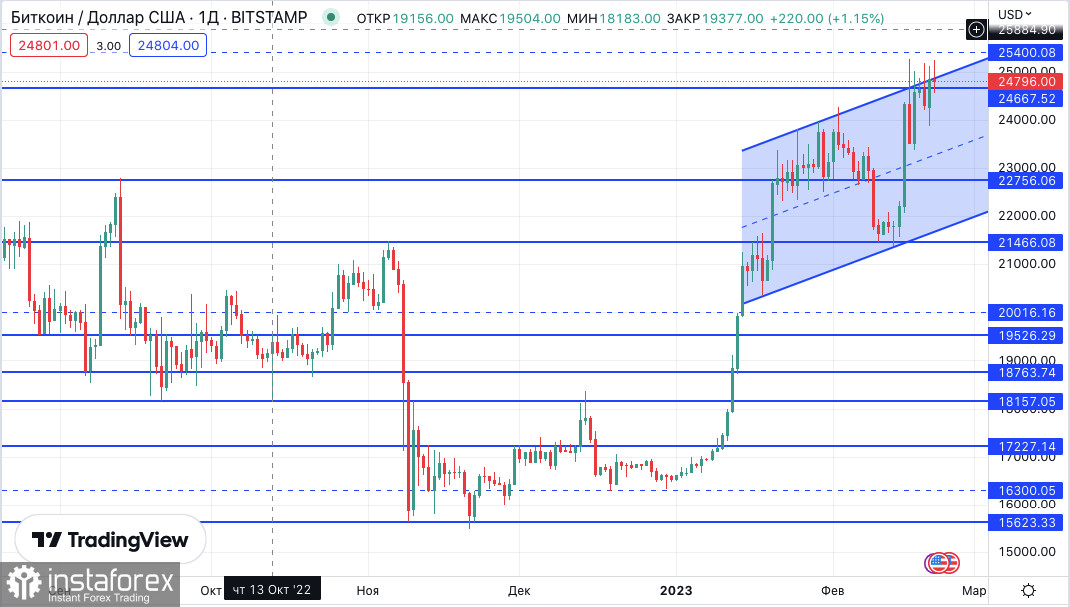Bitcoin's technical situation has remained unchained. Any significant moves on Wednesday before the release of the FOMC meeting minutes are unlikely. BTC is likely to continue to fluctuate near the $25,000 area.
While investors await short-term drivers and clarity, let us have a look at events happening behind the scenes, as well as the potential impact of yesterday's decision by Hong Kong regulators on the crypto market.

Institutional capital outflows from digital investment products
According to the latest report by digital asset manager CoinShares, outflows from large institutional investment digital asset products hit the highest level this year.
The report said the following:
"Digital asset investment products saw outflows totaling $32 million last week, the largest since late December 2022. Midway through last week the outflows were much higher at $62 million, but sentiment improved by Friday with inflows of $30 million."
As usual, long-BTC products were hit the heaviest. Meanwhile, short-Bitcoin products enjoyed the second-most year-to-date inflows, being only behind long-BTC products.
"Bitcoin bore the brunt of the negative sentiment, seeing nearly $25 million of outflows, while short-bitcoin investment products saw inflows of $3.7 million and has seen some of the largest inflows YTD of $38 million, second only to Bitcoin with $158 million."
Analysts at CoinShares noted that negative sentiment has been very uneven. Outflows from Ethereum, Cosmos, Polygon, and Avalanche were estimated at $7.2 million, $1.6 million, $0.8 million and $0.5 million, respectively. At the same time, Aave, Fantom, XRP, Binance, and Decentraland received inflows between $0.36 to $0.26 million.
New sideways trend ahead for Bitcoin
Meanwhile, popular crypto analyst Benjamin Cowen has suggested that Bitcoin is set to move within its price range for much of 2023.
Cowen examined at the MVRV Z-score indicator, which compares the realized value of an asset to its market value.
The MVRV Z-score highlights the extremes in the data between market value and realized value to attempt to identify long-term trend reversals.
According to Cowen, BTC could in theory consolidate within its range until 2024 before a sustained bull market rally begins.
"I would argue that what you're most likely going to see this year is a recovery year, where you spend about half the time moving higher, and half the time moving lower. You can break that up in different months, so you know 2018, 2014, 2022, we had like eight or nine red months, but in the recovery years, it's split more or less half and half."
Cowen predicted that both the MVRV Z-score and Bitcoin's price could surge in 2024 after a recovery year, which would then lead to a halving.
"Once we get into 2024 and the next halving, ideally, a rally, a more of a sustained rally where we see the MVRV Z-score go to much higher levels."
Hong Kong - new crypto market driver
Yesterday, a notable event occurred that could become a new bullish driving force for the cryptocurrency market.
The Securities and Futures Commission of Hong Kong released a statement outlining its plan to allow both institutional and retail investors to trade cryptocurrencies such as Bitcoin and Ethereum.
Cryptocurrency exchanges in Hong Kong could obtain a Virtual Asset Service Provider (VASP) license to operate legally in China's special economic zone.
Why can Hong Kong trigger a bull rally in the crypto market? The opening of Hong Kong for crypto means a massive influx of new funds could be possible. Hong Kong is the fourth largest financial center in the world after New York, London, and Singapore, making it one of the largest global metropolitan hubs.
Moreover, this special economic zone is seen as the primary opportunity for wealthy residents of mainland China to move their capital out of the isolated country. It is estimated that mainland Chinese are moving about $500 billion in the special economic zone in order to gain access to the global financial system.
Although Hong Kong will not have truly decentralized cryptocurrency applications and self-storage, this infusion of new capital could be very good news for cryptocurrency markets.
Rising liquidity in China
Hong Kong's plans to become a crypto hub coincide with China's reopening after the coronavirus pandemic. Last Friday, the Chinese central bank performed the largest liquidity injection in its history to help pull the country's economy out of its historic slowdown. About $92 billion was injected to lower borrowing rates and ease access to cash, which was very similar to the Fed's measures during the pandemic.
It also has implications for cryptocurrencies. Analysts note that the People's Bank of China is the third-largest central bank in the world, with about $6 trillion in assets, and plays a key role in global liquidity.
Japan has the fourth-largest central bank in the world. Together, these two countries provide liquidity to global markets, moving far ahead of the Fed's tightening measures. As a result, global liquidity is already on the rise.
Meanwhile, cryptocurrencies are not tied to any particular economy or organization, but are rather liquidity consumers - they are waiting for the risk-hungry investor to get their money and bet on the fastest horse. That is precisely what might happen this year in China.
Economists expect the People's Bank of China to play its part in stimulating the Chinese economy and cut interest rates in the coming months to support and encourage a sustained economic recovery.
Not all of the money injected by the PBoC will end up being invested in risky assets. But the opening of Hong Kong as a crypto hub, combined with Chinese monetary policy, could prove to be the catalyst for a new Bitcoin bull market.
 English
English 
 Русский
Русский Bahasa Indonesia
Bahasa Indonesia Bahasa Malay
Bahasa Malay ไทย
ไทย Español
Español Deutsch
Deutsch Български
Български Français
Français Tiếng Việt
Tiếng Việt 中文
中文 বাংলা
বাংলা हिन्दी
हिन्दी Čeština
Čeština Українська
Українська Română
Română

